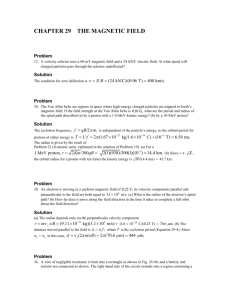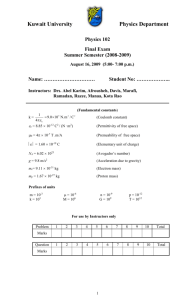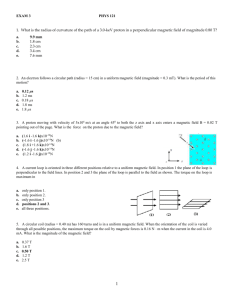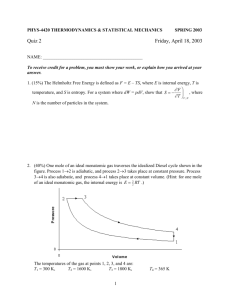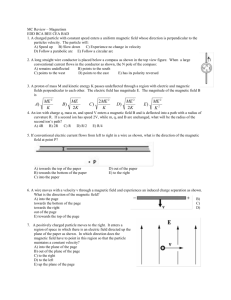Problem Set 8
advertisement
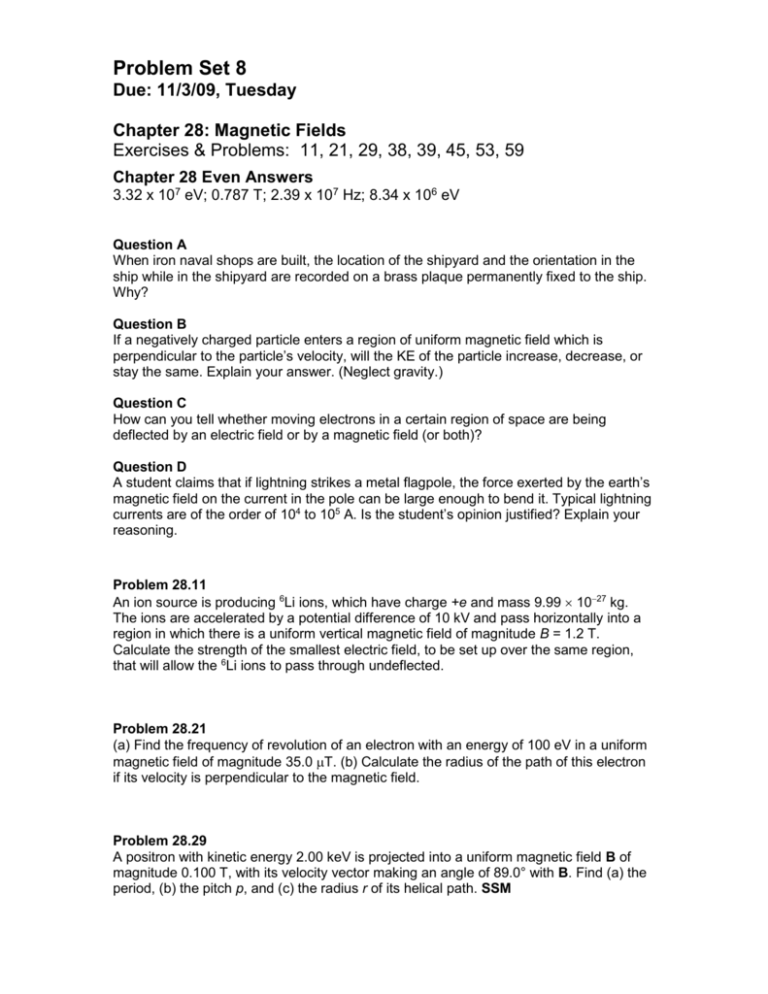
Problem Set 8 Due: 11/3/09, Tuesday Chapter 28: Magnetic Fields Exercises & Problems: 11, 21, 29, 38, 39, 45, 53, 59 Chapter 28 Even Answers 3.32 x 107 eV; 0.787 T; 2.39 x 107 Hz; 8.34 x 106 eV Question A When iron naval shops are built, the location of the shipyard and the orientation in the ship while in the shipyard are recorded on a brass plaque permanently fixed to the ship. Why? Question B If a negatively charged particle enters a region of uniform magnetic field which is perpendicular to the particle’s velocity, will the KE of the particle increase, decrease, or stay the same. Explain your answer. (Neglect gravity.) Question C How can you tell whether moving electrons in a certain region of space are being deflected by an electric field or by a magnetic field (or both)? Question D A student claims that if lightning strikes a metal flagpole, the force exerted by the earth’s magnetic field on the current in the pole can be large enough to bend it. Typical lightning currents are of the order of 104 to 105 A. Is the student’s opinion justified? Explain your reasoning. Problem 28.11 An ion source is producing 6Li ions, which have charge +e and mass 9.99 1027 kg. The ions are accelerated by a potential difference of 10 kV and pass horizontally into a region in which there is a uniform vertical magnetic field of magnitude B = 1.2 T. Calculate the strength of the smallest electric field, to be set up over the same region, that will allow the 6Li ions to pass through undeflected. Problem 28.21 (a) Find the frequency of revolution of an electron with an energy of 100 eV in a uniform magnetic field of magnitude 35.0 T. (b) Calculate the radius of the path of this electron if its velocity is perpendicular to the magnetic field. Problem 28.29 A positron with kinetic energy 2.00 keV is projected into a uniform magnetic field B of magnitude 0.100 T, with its velocity vector making an angle of 89.0° with B. Find (a) the period, (b) the pitch p, and (c) the radius r of its helical path. SSM Problem 28.38 A cyclotron with dee radius 53.0 cm is operated at an oscillator frequency of 12.0 MHz to accelerate protons, (a) What magnitude B of magnetic field is required to achieve resonance? (b) At that field magnitude, what is the kinetic energy of a proton emerging from the cyclotron? Suppose, instead, that B = 1.57 T. (c) What oscillator frequency is required to achieve resonance now? (d) At that frequency, what is the kinetic energy of an emerging proton? Problem 28.39 A 13.0 g wire of length L = 62.0 cm is suspended by a pair of flexible leads in a uniform magnetic field of magnitude 0.440 T (Fig. 28-44). What are the (a) magnitude and (b) direction (left or right) of the current required to remove the tension in the supporting leads? ILW Problem 28.45 A 1.0 kg copper rod rests on two horizontal rails 1.0 m apart and carries a current of 50 A from one rail to the other. The coefficient of static friction between rod and rails is 0.60. What are the (a) magnitude and (b) angle (relative to the vertical) of the smallest magnetic field that puts the rod on the verge of sliding? Problem 28.53 Figure 28-50 shows a wood cylinder of mass m = 0.250 kg and length L = 0.100 m, with N = 10.0 turns of wire wrapped around it longitudinally, so that the plane of the wire coil contains the long central axis of the cylinder. The cylinder is released on a plane inclined at an angle to the horizontal, with the plane of the coil parallel to the incline plane. If there is a vertical uniform magnetic field of magnitude 0.500 T, what is the least current i through the coil that keeps the cylinder from rolling down the plane? Problem 28.59 Two concentric, circular wire loops, of radii r1 = 20.0 cm and r2 = 30.0 cm, are located in an xy plane; each carries a clockwise current of 7.00 A (Fig. 28-51). (a) Find the magnitude of the net magnetic dipole moment of the system. (b) Repeat for reversed current in the inner loop. SSM


